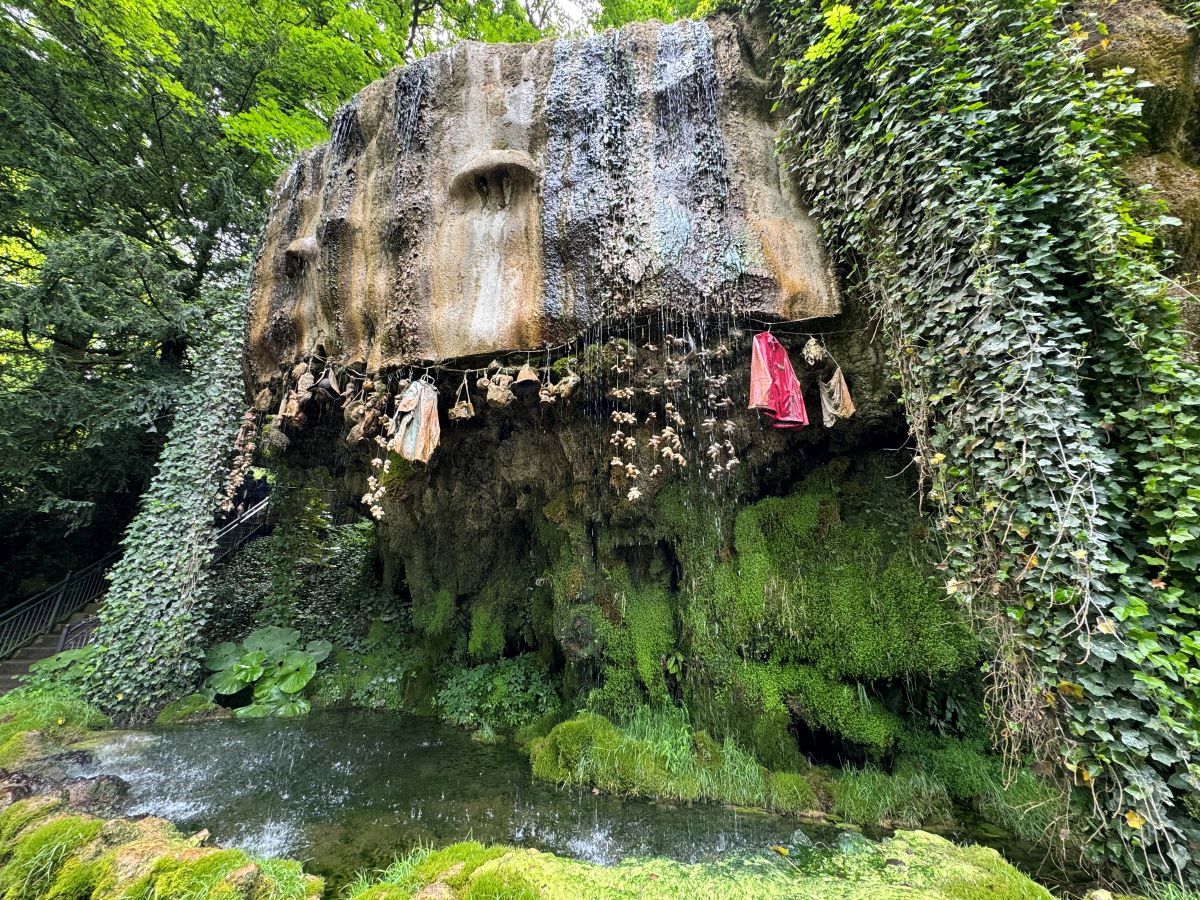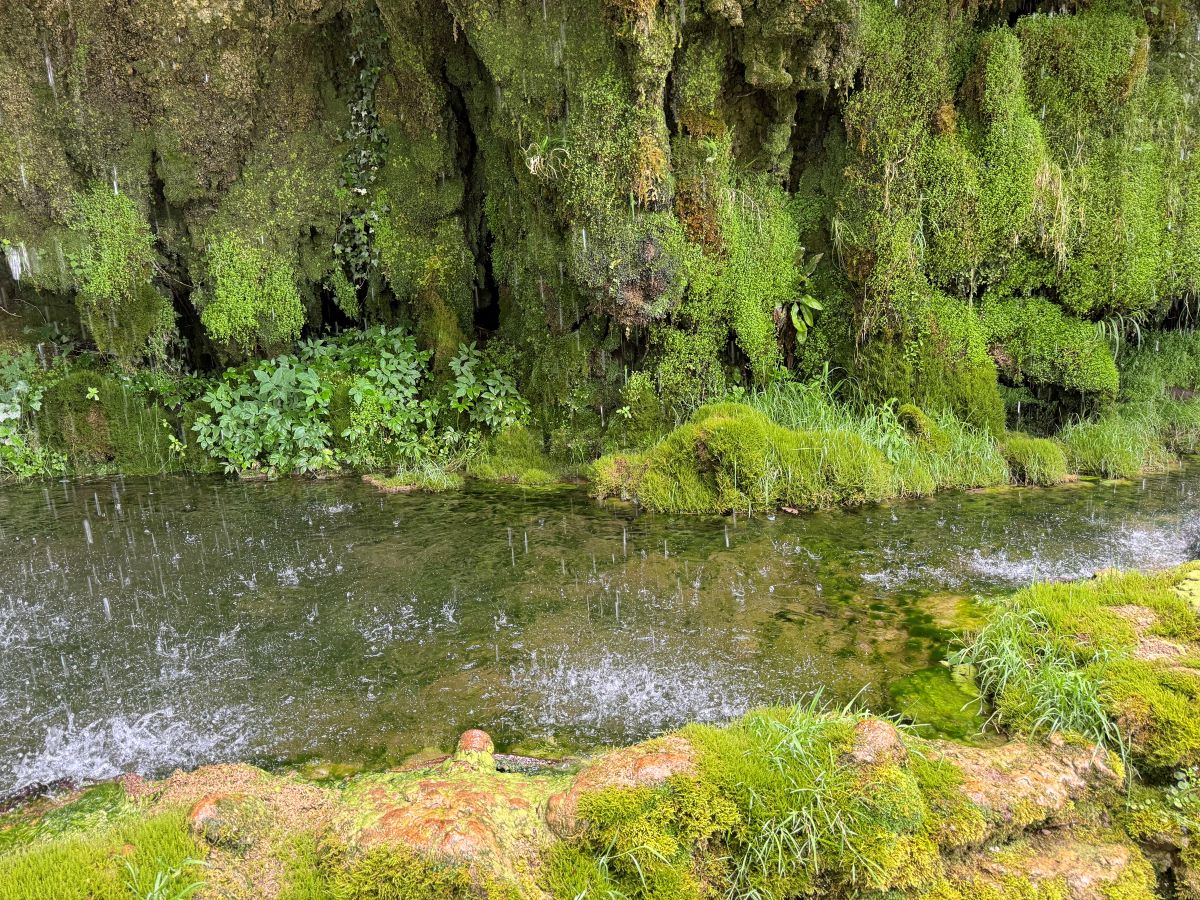The Long Walk, in Knaresborough, is almost certainly the only registered park and garden which developed around a petrifying well and the cave home of a soothsayer (it is registered at Grade II). Established in the eighteenth century around these much older attractions, it continues to attract visitors today, but has considerably more to offer.

Mother Shipton
The site is now owned and run as ‘Mother Shipton’s Cave’, and tickets are required for entry. As the website notes:
Mother Shipton’s Cave in Knaresborough is England’s Oldest Tourist Attraction, open since 1630, and is also the legendary birthplace of England’s most famous prophetess.
The website outlines the story of Mother Shipton. Ursula Sontheil was born in 1488 in a cave on the banks of the River Nidd, to a single mother. Separated from her mother and raised by a local family, she was ostracised for her allegedly witchlike looks and form, and returned to the cave of her birth. At 24, she married Tobias Shipton, keeping his name after his death within a few years.

Later known as ‘Mother Shipton’, she used her familiarity with the local environment to make traditional remedies, but also predicted the future:
It started off with small premonitions but as she practised, she became more confident and her powers grew. Soon she was known as Knaresborough’s Prophetess, a witch. She made her living telling the future and warning those who asked of what was to come. After a long life, she died in 1561, aged 73.
These prophecies apparently included ‘the fates of several rulers within and just after her lifetime, as well as the invention of iron ships, the Great Fire of London in 1666, and the defeat of the Spanish Armada’. The Register entry notes, however, that:
The rhymed prophecies attributed to Mother Shipton which appeared in [a 1667] pamphlet proved so popular that subsequent pamphlets with more extravagant predictions appeared, and the tradition continued at least until 1873 when forgeries… were made by a Brighton bookseller.
Origins of the Long Walk
With the discovery of mineral springs in Knaresborough in the sixteenth century, Knaresborough started to develop as a spa town. Henry VIII’s antiquary, John Leland, visited in 1538 to research the Dropping Well adjacent to Mother Shipton’s cave, writing that ‘out of great rocks it emits water continually, the water is of such a nature that whatever is cast in and is touched by this water turneth to stone’. The ‘Dropping Well’ became widely-renowned, particularly after 1626, when Knaresborough was promoted as a spa town by Edmund Deane in Spadacrene Anglica, or the English Spawe Fountain. As noted by the owner’s website, the site is the oldest tourist attraction in England to charge a fee, having opened in 1630. The attraction includes the well itself – which looks like a skull and (after some time) ‘petrifies’ items, due to the concentration of sulphate and carbonate in the spring water – a wishing well, and of course Mother Shipton’s cave.

Celia Fiennes made a visit to Knaresborough in 1697, and described both the town and the Dropping Well:
… the town is a pretty stone building, in it a large Market place, there is a River-the water looks black, I fancy it runns off from the Iron and Sulpher Mines which changes the coullour — we pass it over on a large bridge, tho’ in some places they may ford it, its all on a rock and the side of the hill by the River is all rock, and the little houses are all built in the rocks….
… the fourth Spring… is of a petrifying quality, turnes all things into stone, it rises in a banck on the top of a hill and so runs along in a little Channell about a foote over, and all the ground it runns over is moorish and full of holes, with water standing in it, which stincks just like the Sulpher Spaw, and will turn Silver to the coullour of Copper as that does, notwithstanding this clear spring runns through it with a swift current to the brow of the hill and then it spreads it self all round the hill, which is a Rock, and so runns down all over the brow of the hill continually, like a hasty shower of small and great raine, and so it meetes in the bottom and runns all into the river Knarsborough; and this water as it runns and where it lyes in the hollows of the rock does turn moss and wood into Stone…. the whole rock is continually dropping with water besides the showering from the top which ever runns, and this is called the dropping well; there is an arbour and the Company used to come and eat a Supper there in an evening, to have the pleaseing prospect, and the murmuring shower to divert their eare; in a good space of tyme it will harden Ribon like Stone or any thing else.

Daniel Defoe’s early eighteenth-century commentary is a little less enthusiastic. Whilst he noted Knaresborough’s ‘very fine bridge’, and ‘no less than four spas or mineral waters’, he had perhaps too much experience of spas already:
The first thing recommended to me for a wonder, was that four springs, the waters of which are in themselves of so different a quality, should rise in so narrow a compass of ground; but I, who was surfeited with country wonders in my passing the Peak, was not so easily surprized at the wonderful strangeness of this part….
The springs themselves, and indeed one of them, is nothing extraordinary, namely, that in a little cave a petrifying water drops from the roof of the cavity, which, as they say, turns wood into stone. This indeed I made light of too, because I had already been at Poole’s Hole and Castleton in the Peak….
The Register entry observes that the Long Walk ‘developed as a means of access to the Well’, and was already in use as a promenade prior to being further formalised in around 1739 (as noted here, promenades ‘took off in the mid seventeenth century… examples began to appear across England in provincial towns and cities with aspirations to a polite society, especially in spas and resorts’). At this point, Sir Henry Slingsby – whose grandfather had acquired the land from Charles I, and started charging for guided tours in 1630 – ‘improved the path and planted trees along the river bank’. By 1807 it was being described as a ‘beautiful and romantic walk’. In 1916, however, the Slingsby estate was sold, and the site became regarded as more of an attraction than a walk.
The Long Walk Today
The Long Walk lies on the western bank of the River Nidd, and is roughly a mile long. It runs north to south through a gorge, starting at the High Bridge (Grade II, rebuilt in 1773 and later widened) and concluding at the Low Bridge (Grade II, rebuilt 1779). Access is now currently only possible via the ticket office at the northern end of the site.
The early portion of the path is wide and tarmacked, to allow service access and access to the car park, and lacks the atmosphere of a riverside path – an effect often compounded by the density of the tree cover between the path and the river, which screens views of both the water and the buildings beyond, such as the railway viaduct (Grade II*) and Knaresborough Castle (scheduled) – though more can be seen from the riverside car park, including the eighteenth-century weir (Grade II), which was built to power the wheel of the mill opposite. Extensive tourist facilities, such as a play area and highly-themed refreshment area are perhaps consistent with the site’s longstanding status as an attraction, but further reduce visitor immersion in the surroundings.


Towards the south, though, whilst the wooded character is retained, the river becomes visible, the path less industrial, and the whole experience more enjoyable. The well and cave, despite being the focal point of the whole site, are surprisingly unobtrusive. The ‘rock’ of the well (itself a large mineral deposit) is first observed from above, before the visitor descends a number of stairs to see it up close. The Register entry describes this area as follows:
The steps appear to be in the same position as those shown on engravings of 1739 and of the early C19. The Well is formed by a stream which runs across a level rocky surface at the head of the Well, and then drips over a grooved rock formation with small stalactites along its lower edge which bulges out from the cliff edge. The water contains a strong solution of minerals which precipitate as it runs over the rock and drips down. This quality means that the shape of the rock cap at the top of the Well and the configuration of grooves and stalactites changes over time, hence the slightly differing appearance of the Well in prints and engravings over the years.
If one looks past the (slightly creepy) strings of petrifying soft toys, the overall experience nevertheless remains as described by Celia Fiennes: the spring water still ‘runns down all over the brow of the hill continually, like a hasty shower of small and great raine’.


Behind the petrifying well is the wishing well, lit in a changing array of colours in a way that may not be wholly consistent with its earlier appearance but is oddly mesmerising. Onsite instructions are provided for successful wish-making. Upstream a few paces is the entrance to Mother Shipton’s Cave. Those of a nervous disposition should ensure no one has pressed the button to trigger the cave’s audio tour, which starts with an energetic reimagining of the thunderstorm in which Mother Shipton is thought to have been born.
To the south of the well, and running to the southern (former) entrance is a relatively straight stretch of path, lined with unusually straight beech trees planted by Sir Henry Slingsby in 1739, and – according to the website for the attraction – regarded as ‘some of the oldest and tallest in the country’.

Conclusion
Like the rest of Knaresborough, the Long Walk is definitely worth a visit: it has a certain charm, and the petrifying well is an unusual feature. It follows the topography, and – when the trees permit – allows close access to a relatively undisturbed stretch of river.

